Can’t ignore the Elephant in the control room?
Super 8: Episode 3
In April of 2002 the White Stripes spent two weeks in the studio recording the bulk of what would become their 4th album:
Elephant *. The record is a high point in their career and indeed, when it was released a year later, it went on to win a Grammy. It’s a great sounding record as well, both crisp and warm — you’d be forgiven for thinking it was done in one of those big Nashville rooms, through an enormous console with flying faders, into the latest version of one of those high end DAWs favoured by the film industry like SADiE. When actually it was done at Toe Rag Studios in the east London Borough of Hackney. Toe Rag had a modest live room, it’s desk was rather small (though it was an EMI REDD.17 from Abbey Road) and Elephant was actually recorded onto 8-track analogue tape. I know, in the 21st Century. Can you imagine: only eight tracks for a ‘Seven Nation Army’? All that notwithstanding, the record was made with some very nice old gear — though very little of it from the fine old vintage displayed on the label.
It was claimed on the album’s sleeve that none of the equipment used to make the record was more recent than 1963. I don’t know why that year was picked, it seems purely arbitrary. Much of the gear they used was newer than stated — including, fundamentally, the tape machines. Toe Rag owner Liam Watson said in
Sound On Sound (October 2003 issue) that his Studer A80 machines, both the 8-track machine that was used to record
Elephant and his 16-track recorder, were Mark II models — so they must date from no earlier than the early 1970s. Those decks run 1” and 2” tape respectively, for just about the best fidelity you can get on analogue tape. Three years prior to this there was a pre-Stripes article about Toe Rag in
Tape Op issue #13 that listed the main recorders as a Studer J37 4-track (how's that for a nice Beatlesy match for the REDD.17) along with the A80 8-track that would later be used for
Elephant **. As for the ¼” Studer RC stereo master recorder mentioned in
SOS, well that A80/B62 series hybrid wasn’t put together for the first time until 1979. We too have a ¼” half-track at New Cut Studios for mixing to tape and guess what: it is a Studer A80. It has an inventory sticker for BBC Scotland and as I’ve done the odd TV show up in Glasgow’s West End I like to think it came from there.
“Had a dream that you pulled the trigger”
I also like to think that the rest of the
Elephant sleeve statement about the recording process is true and that "No computers were used during the writing, recording, mixing, or mastering of this record”. I don’t know how much of
Elephant was recorded through the 12 channel valve REDD.17 desk or how much through the 18 input solid state Calrec M-series console which was also housed at Toe Rag at the time of the
Elephant sessions. The REDD of course was definitely pre-1963: the first .17 was built by EMI’s Recording Engineering Development Department in 1958 and they made just three more, before improving the design to the REDD.37 the same year. Only three .37s were built and by
Elephant’s alleged 1963 cut-off the EMI boffins had just about completed the REDD.51 design with higher headroom courtesy of the new solid state REDD.47 pre-amps. Toe Rag’s Calrec M on the other hand, was a broadcast desk custom built for BBC Television Centre in the early 80s (when they shopped around for cheaper alternatives to Neve). It is this desk that seems to get the most mention in reference to
Elephant and the REDD.17 may not have been used by the White Stripes at all. Funnily enough I got to see the Toe Rag Calrec in it’s next home after it was bought by Dan Hawkins of The Darkness. He installed it in his residential studio at Leeders Farm — a beautiful 17th century barn conversion just off the A11 between Thetford and Norwich. In March 2009 it was our base of operations for a UK tour with Dan’s other band Stone Gods. By the time I got to see it the quadrant faders (with trigger shaped red knobs: possibly Paintons?) that Liam Watson had put across the inputs had been restored to the Penny & Giles strips the Calrec was originally built with.
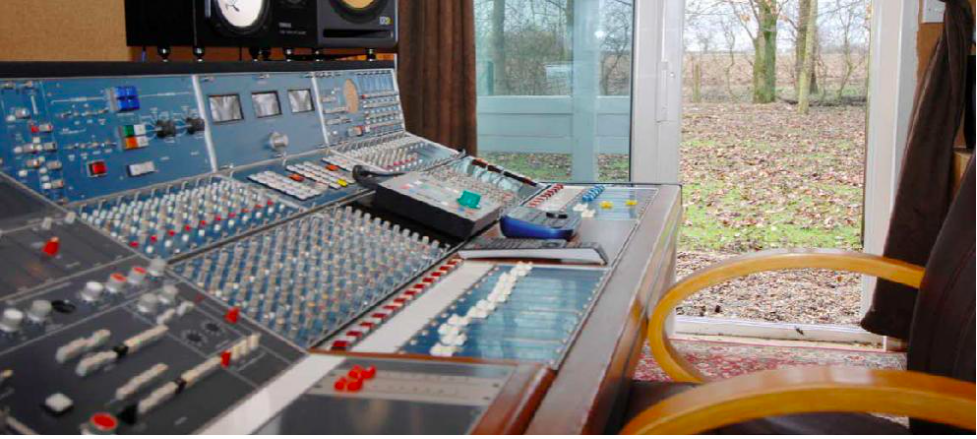
Either way, either desk would have had enough channels to handle the way
Elephant was tracked. In a 2006 interview on the BMI website, Liam Watson gives an insight into how the recording sessions were structured to maximise the space available on an 8-track machine. I was particularly interested to read that Jack White’s guitar was recorded onto two tracks through two separately mic’d amps. For the rest Watson described his technique thus: “I miked the drums with AKG dynamic and condenser mics, and used a Shure dynamic mic on the snare. I mixed the drums to a single track, except for the bass drum, which had a track of its own.” Additionally the kick drum was also mixed up front with a fair bit of compression. The band would first track a live take with guide vocal and, once the Whites were happy with a take, another guitar part was added through the same dual amp & mic set-up. Recording the lead vocal was approached a little differently as well. Watson used a vintage Neumann large diaphragm condenser conventionally, but second mic’d with a Shure dynamic into “a small guitar amp” with an AKG dynamic in front of that. This AKG was mixed with the Neumann, processed with some tape delay, spring reverb, and compression and then recorded over the guide vocal track. A second vocal pass was then added to the last remaining track on the Studer. Finally a lead guitar part was tracked using the same two amp setup: this time mixed to that last track, dropped in between the vocal overdubs. The complete track listing is as follows: Track 1 guitar overdub - amp 1; Tr.2 main vocal; Tr.3 live guitar - amp 1; Tr.4 drums; Tr.5 bass drum; Tr.6 live guitar - amp 2; Tr.7 guitar overdub - amp 2; Tr.8 secondary vocals/lead guitar solo. I wonder what that “small guitar amp” was, a Fender Champ, or maybe even smaller like a Selmer Little Giant? Of course given the amount of evidence for post-'63 gear there’s nothing to say that it wasn’t completely modern and full of chips. The clarity of a solid state amp would work well for the vocal.
“Hear the Salvation Army band, down by the riverside”
The monster riff of ‘Seven Nation Army’, the opening salvo of Elephant’s sonic assault — it’s a sound that has entered the collective consciousness. It’s been used from sports stadia to political rallies to video games (as I write this Samsung are currently running an advert with a 2012 cover of the song by Zella Day). I once heard it described as the second most identifiable guitar riff in history after the Stones’ 'Satisfaction'; if you’re under 30 it’s probably the first. The song was born of a sound-check riff when the White Stripes appeared onstage at the Corner Hotel in Melbourne, on the 29th & 30th of January during the 2002 Big Day Out tour. The title ‘Seven Nation Army’ came from a memory Jack White had of mishearing “Salvation Army” during his childhood in Detroit***. In the hypnotic video White mimed his parts on an Airline Jetson (at the time a long forgotten ’60s guitar) that he got really cheap from Jack Oblivian. This Jetson/Hutto model guitar didn’t debut until 1964, so again, past the cut-off date for the vintage voodoo vainglory declared in the ‘sleeve notes’****. Despite the red & white visual onslaught of the promo the song was actually recorded on a very brown guitar: a single pickup Kay K6533 archtop (although the fibreglass Airline was used extensively on the album). On page 174 of Guitar Stories Vol. 2 (Michael Wright; Hal Leonard, 2000), in the third column under Electric Hollowbody Guitars, the K6533 Value Leader lists the dates available as 1957-59. So there’s one thing at least that meets the pre-’63 protocol. I don’t know if Jack fell lax and broke his axe but his Value Leader ended up wrapped in vinegar & brown paper. White used the same K6533 recently to play the national anthem at the Detroit Tigers’ Comerica Park opening weekend and it’s still wearing the cut-price coverlet of a plain paper, ragged wrapper*****.
For ‘Seven Nation…’ the Kay’s ‘cheese-grater’ neck pup first went through a Whammy, then through a Muff, to create the octave-down bass line and fuzz-sustained slide parts. Presumably it was then Y-split, maybe with an A/B box and sent to the two amp set-up Watson described. And there’s a good chance that one of the amps in that twin amp setup was actually a Twin. The post FX signal was possibly split, as per his live rig at the time, into the Silvertone 1485 amplifier White then favoured and a Fender Twin~Reverb. In that interview for Broadcast Music Inc. I mentioned earlier, Liam Watson said “Jack’s guitar was going through two separate amps at the same time; I miked these with AKG and Shure dynamic mics, each amp having its own track.” The department store amp head (the 1485 was the largest of the amps Danelectro made for Sears) would have had to go into a matching Silvertone cab driving six 10” Jensen C10Q ceramic speakers. As we’ll see, the output stages of this amp require a very specific cabinet, unless the head’s been heavily modified.
Jack White used a 1484 on some of the Stripes earlier albums, up to and including some tracks on
White Blood Cells. The similarity in nomenclature between the 1484 & 1485 Silvertone heads and White’s usage of both at different times is tricky to navigate. From the front the two amps look identical except the ’84 says Twin Twelve in the top right corner of the faceplate and the ’85 says Six Speakers: both labels in reference to their relative cabinets. According to Silvertoneworld.net both models were were introduced in 1963, so they just fit the pre-Kennedy assassination cut-off for
Elephant. The more research I’ve done however, the less I think a Silvertone appears on
Elephant at all. The consensus of opinion on the Silvertone/Fender pairing is that, certainly on stage, the 1485 was providing the grit and the Twin the chime — and of course the reverb. There’s a very integral atmospheric element in ‘Seven Nation… ‘ that has to be a spring reverb, so why wouldn’t that come from an amp with a tank? Those Danelectro-built Sears amps are great dirt boxes but their reverb is reckoned to be comparatively poor. It is a short single-spring device, in a metal can with a Masonite base, and if you drive it hard it sounds tinny and aquatic. You can get some unique sounds out of it though, which must have appealed to Jack White, and the Dano tremolo is decent. Incidentally Neil Young used a Sears six-ten with The Bluenotes.
There’s the further confusion of people ‘in the know’ referring to the 1484 & 1485 as 50 watt and 100 watt respectively. The Silvertone 1484 that White said he used on the first two albums has two 6L6 output tubes which in this Danelectro design will never give you more than about 35w RMS. If you upgrade the wimpy output transformer of a 1484 and pop in a pair of quality 6L6GCs you might get 50w out of it. Really though, this amp is much more like a Vibralux~Reverb rated at 35 watts — nothing like the “60 watts music power" listed in the old Sears catalog. But then that was probably a peak-to-peak reading. While Americans now usually accept RMS levels as the common international reference, people don’t always remember that the ‘Madmen’ of yesteryear always published the “bigger is better” numbers of peak-to-peak readings. Because of this, in older literature amps are often listed with both “American wattage” and “British wattage”. Then there's the confusion people have made with, say Marshall designs. The 1485 wasn't a doubled 1484, rather it had dual 1484 power amp stages. Instead of a nice big OT with lots of mass to handle the low end, the 1485 had two of the same feeble trannies as the 1484, each driving separate sets of three 10” speakers in the same cab, so nowhere near 100 watts root mean square. When White upgraded to the 1485 it was not to a nice big hundred watt stack. What he was really getting was an amp with two outputs, each of about 35w at roughly 2.5Ω. If you’re playing through two AC30s you’re not using a 60w amp, even if you build them both into the same box. You can build twenty Champs into one big cabinet and split your guitar signal 20 ways into all those 5 watt amps at the same time — you're not playing through a 100 watt amp and it won't sound like it either.
“And that ain’t what you want to hear…”
People often remark that Jack White’s use of Fender Twins in the live environment during this period (often disguised & draped in red cloth) means he was probably using them in the studio as well. Others have gone further and opined that the Silvertone amps were mere set dressing to bolster his mojo mythology. I can tell you now that I have worked with artists who were easily persuaded (after a few bad experiences of vintage gear failing at shows) that the mojo-rich pawn shop treasure that sounded so great in the studio would be better replaced by an industry standard bit of kit — even a vintage one like a nice '70s twin — that would be a more reliable tool on tour. And this applies to amps more often than any other type of gear. Especially a box made of MDF with a thin linen skin like the 1484/85, that’s going to split and crumble every time it takes a little knock. Danelectro always favoured cheap materials like fibreboard, masonite and old lipstick cases. But those Sears Danos are great overdrive amps so why wouldn’t he be using them, especially in the studio? White claims to have used old Silvertones for the first two Stripes albums, so why not use them again for
Elephant? In the years immediately following their Grammy win Jack White’s stage rig consisted of a Silvertone 1485 & 6x10 paired with a Silverface Twin~Reverb; both amps appeared to have been re-covered in a red material with white grill cloths as can be seen in the picture above.
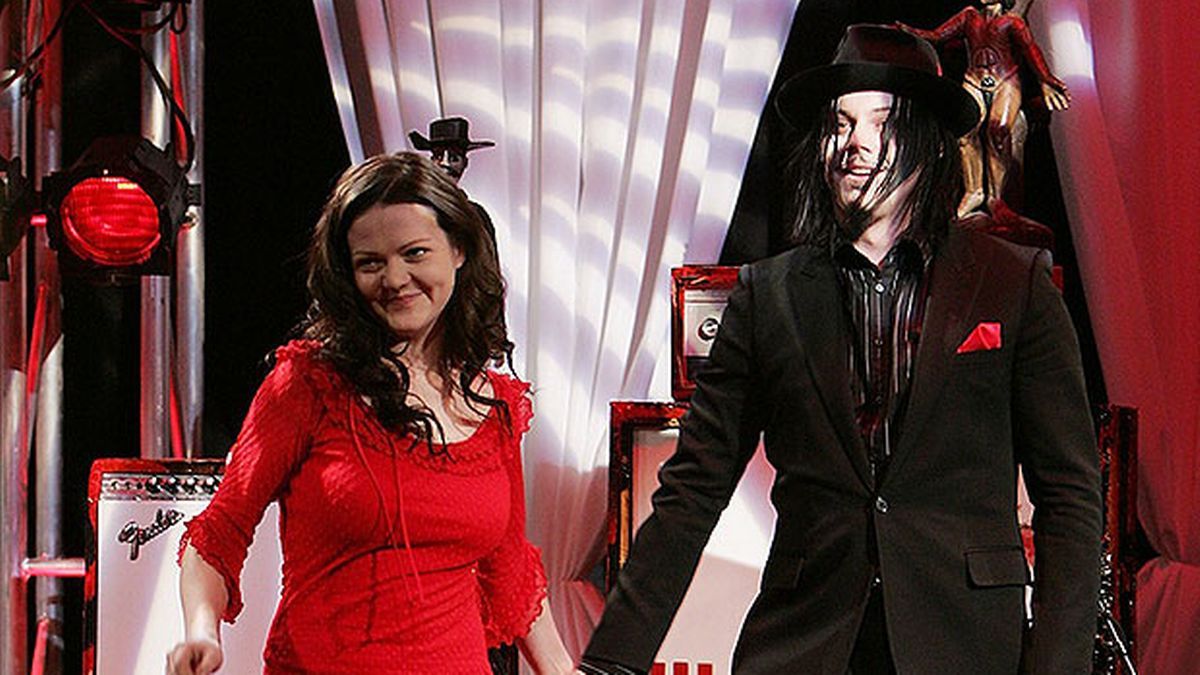
At some point he got two red re-covered 1485 rigs and they can both clearly be seen sitting next to a red jacketed Silverface Twin, in the footage shot at BBC Maida Vale Studio 3 for their 2005
From The Basement session. There are some great shots of the red Airline too but the Jetson has had it’s neck pickup pulled, and most of its harness as well, judging by the paucity of knobs. We don’t have any Silvertone amps at New Cut Studios, but we do have a Twin~Reverb: and you know what? It’s a 1977 Silverface — although it’s had a few modifications to bring down the ultra-linear output level to a more Blackface wattage. From some angles in that footage you can also clearly see two Sonic Machine Factory combos stacked over-under, though from their position at Stage Left behind the keyboard rig I assume they were only used for keys (I later found a listing for one of these amps at Online Nashville Auctions being sold with its White Stripes flight case as Lot#:64 and it was labelled with gaffa & sharpie as "Wurly", so it was obviously used for White’s 200A electric piano). The faceplate of the SMF 15 Watters proclaimed them to be All Tube Class A, but their tube chart said they had a pair of EL84s. Now maybe they were two single ended channels in one chassis, but that would give you two 10 watt ouputs at best. I can only assume they are really a ClassA/B amp along the lines of an AC15. The same keys rig with two red SMFs appears again in more footage from MV3 (supposedly from 2007), but by this point the Silvertones have flown and there’s a row of three Blackface reissue Twins — in red coats, natch — and the Hutto once again has two pups. It’s maybe a different guitar.
“The Salvation Army seemed to wind up in the hole”
I can’t say for sure what amps were used on ‘Seven Nation Army’, or on the rest of the album, as there were some nice old amps already on the premises at Toe Rag. In that 2006 BMI article Watson said “I was in a band that supported the White Stripes on their first UK tour. We told Jack about the studio and he came along to have a look, liked it and later booked a session.” Having taken the tour Jack may even have decided not to bring his own amps to the sessions at all, given the complement of vintage boxes already housed at Toe Rag. There are photos in that SOS article (entitled 'Liam Watson & Toe Rag Studios') of some fine old heads & combos. Stacked up in one picture are, I believe, a Vox AC30, a Silver Croc Selmer Zodiac, a Vox AC50 head, and what looks like a 5D5 Wide-Panel Tweed Fender Pro. I’m pretty sure the Silver Croc is a Zodiac because the Twin Thirty & Twin Fifty Zodiacs are slightly wider than the Voxes it’s sandwiched between. Actually, Selmer 30 watt & 50 watt Twin combos (both Zodiacs & Thunderbirds) were similar dimensions to an AC30 but about two inches wider. So yeah it could be a Thunderbird, but Zodiac Twin 30s are more common. I’ve seen a few over the years but the only time I’ve ever toured one was with Alpha supporting Massive Attack on the
Mezzanine tour in ’98. There’s also another
SOS photo of a 50w Selmer Treble N’ Bass Mk.II with matching 2x12 cab in the hexagon grill cloth, Blue/Black livery, issued from 1965-67 which immediately followed the Silver Croc-skin era. By 1965 all the imitation silver crocodiles were hunted out of existence in the Essex marshes, and Kenney Jones & Ronnie Lane, having used up all the remaining hides, had quit Selmer to form the Small Faces. I own two of the mighty Little Giant amps Selmer made in the 1960s and one of them is a Silver Croc, the other a Blue/Grey. Now, the Little Giant is a true Class A amp pushing a single EL84 in a similar design to the Vox AC4. We also have our own Selmer Treble N’ Bass at New Cut Studios: a T N’ B Compact 50R SV, from the 1970-74 Silverface period.******
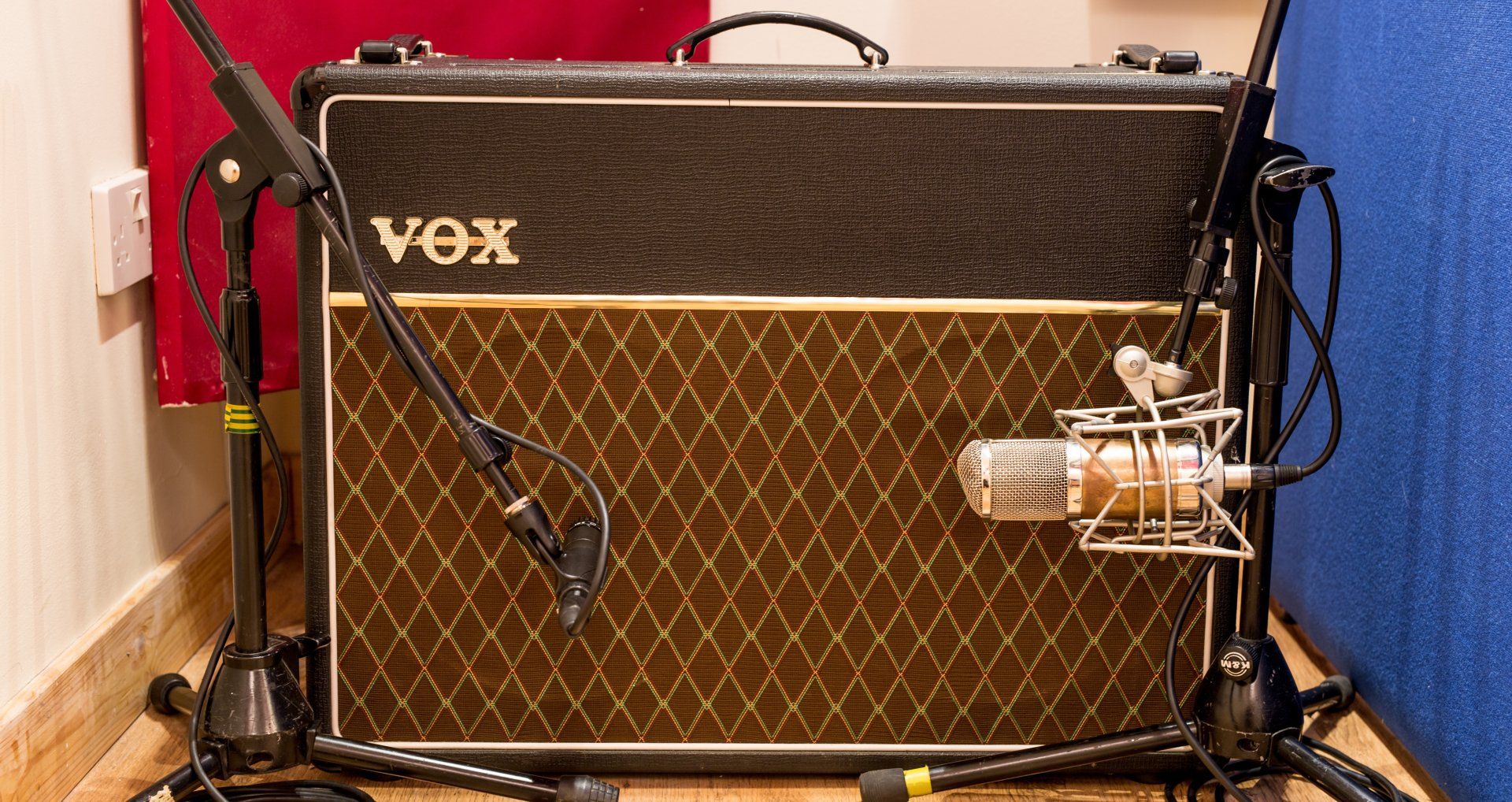
And yes, of course we have a Vox AC30 at New Cut, its a 1999 Marshall-built TBX with Blue Bulldogs. The AC30 in the Toe Rag amp stack pic is covered in black vinyl, but I read in a Guitar.com interview with Lincolnshire guitarist Eddie Tatton, that he bought a fawn AC30 that he was told was used on
Elephant. Mind you, if the resident AC30 changed in the 6 months between the White Stripes occupation and the
SOS article, maybe all of the other pictured amps were also newer acquisitions, flushed as Watson was with his elephantine earnings. Then again, Mr. Tatton may have been misled altogether, and there’s just as much argument for the two guitar amps on ‘Seven Nation…’ being the SIlvertone 1485 and Fender Twin~Reverb Jack White was familiar with. So there’s quite a range of choice for what that dual amp set-up might have been. Not that the same two amps had to be used for every track on the album.
I kept searching for a definitive answer on the question of ‘which amps’ and found people claiming in forums that White used both a 30w Selmer and an AC30 at Toe Rag because he didn’t want to bring his 1485 across the pond. But they don’t specify that it was a Vox/Zodiac pairing. I eventually found another, unreferenced quote online from Liam Watson that claimed yet another combination. I couldn’t track down the original publication, but it had more detail about the miking of the twin guitar rig as well : “
‘We tracked on 1" analog tape using a Studer A-80 8-track,’ says Watson. ‘Jack used two amps for the sessions — his Fender Twin Reverb and a Selmer Truvoice Zodiac Twin 30. The Selmer took the place of his Silvertone amp, which he didn't want to ship to England. I close-miked the amps with Shure 545 and AKG D25 mics in various configurations. For acoustic guitar tracks, a borrowed Martin was miked with a single STC 4038 ribbon mic. (A Burns acoustic had been used for ‘It's True That We Love One Another’). Jack wanted to mic the acoustic in stereo for ‘You've Got Her in Your Pocket’, and I never really do that. I had to pull out my BBC recording manual from the late '50s and look up some stereo-miking techniques!’
”. There’s a pair of BBC 4038s prominently used on bongos and guitar in the 2005 film from BBC MV3 during ‘Ugly As I seem’.
You know I’m going tell tell you that we have a pair of Coles 4038s at New Cut should you want to try out stereo miking, or even recording bongos and acoustic.
"Oh man, I need TV when I've got T.Rex".
So there you have it, Watson himself specifies a Twin. In fact he says it was a pair of twins; a Selmer Twin Thirty as well as a Fender Twin Reverb (but no Sears Twin Twelve). But then in the same quoted passage Watson allegedly said that only one piece of outboard was used on the whole album — that being a Urei 1176 compressor on one vocal track. Doesn’t this contradict his remarks in the BMI interview about lead vocals also being put through tape delay and spring reverb? Ahh, unless he was only referring to the parallel vocal recording via a small guitar combo with internal and inline effects. So who knows, as I said before, different pairs of amps might have been used in different sessions. I would postulate that Jack White took a Fender Twin along (maybe even just a tour rental amp), and alternated pairing it with an AC30 and a Zodiac 30. The Selmer Zodiac is a fantastic amp and in the early ‘60s it was perhaps the the AC30s only real homegrown competition. Of course the AC30 could have predated 1963, it was first released in 1959, but the Zodiac was only introduced in 1963 and was only produced in it’s Croc Skin coat until 1965. In the 1961-63 Blue & Grey period the very similar forerunner of the Zodiac was called the Twin Selectortone.
“And the children drank lemonade”
With half of the tape given over to guitar (in fact there’s guitar on 5 of the 8 tracks, if we count the solo) you might wonder if some fancy processing was going on. For an album with a variety of great guitar sounds you might be surprised to discover that Jack White supposedly only used the same two effects pedals throughout (though I think we can probably add a third made by Boss). As for ‘Seven Nation Army’ one was a Digitech Whammy and the other was a Big Muff Pi, and they were apparently patched in that order, at least when he first started using that pairing. Now, the first Electro-Harmonix Big Muff
π, version 1 ‘Triangle’ model, wasn’t made until a good six years after the claimed technological cut-off of 1963 — and I distinctly remember when Digitech first put out the Whammy in 1989. Whether White used any other pedals on
Elephant or not, these two are the pedals most prominent on ‘Seven Nation Army’. The first model of Whammy White was seen to use was the XP-100 Whammy-Wah. As already mentioned, the Whammy was obviously used in ‘Seven Nation…’ to drop an octave for the distinctive ‘bass line’ riff. But during shows he was also seen to turn it’s input gain pot (the small black knob next to the input jack on it’s front panel) to overdrive both the Muff and his amps. This was a function that was later taken over by a Boss CS-3 Compression Sustainer, partly due to the Whammy having changed to a regular WH-4 with no input gain pot, sometime before February 2002. The CS-3 was in turn replaced by an MXR Micro Amp after about a year (possibly a tip learnt from supporting The Strokes in the summer of 2002). Maybe he kept the XP-100 just for recording, but if he used his WH-4 for
Elephant then he may very well have used a Boss CS-3 in front of it. Maybe he only used the XP for ‘Well It’s True That We Love One Another’. And here’s an interesting point for all the vintage analogue diehards out there: with both the XP-100 and the WH-4, White’s guitar signal was digitised as soon as it went into the Whammy, even in bypass.
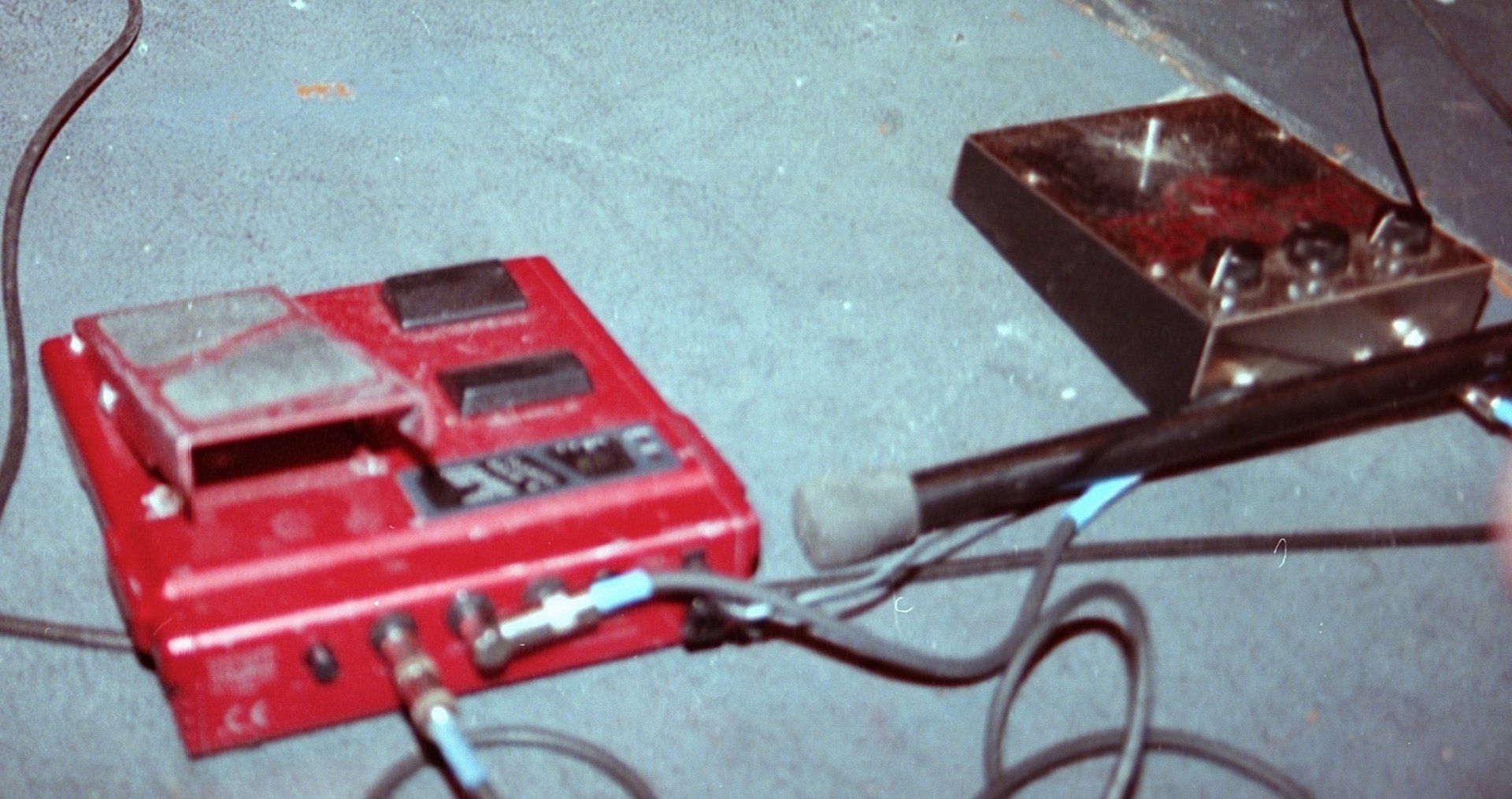
In all likelihood the Big Muff pedal Jack White used for the
Elephant recordings was much later than the original 1969 Triangle model. The earliest reports of Jack White using a Big Muff reference photos from 2000 when he was using a Black Russian Sovtek Muff — and we have a 1999 Black Russian here at New Cut as well, as you can see in the middle of the Muff line up in the picture below. The Russian made Sovtek range that E-H founder Mike Mathews set up had been very popular (beginning with the first Russian Muff: the Red Army Overdrive in 1992). But by the end of the C20th everyone wanted retro gear (or at least the retro look) and that certainly included Jack White. And lets face it the Red & Black graphics of the ’70s
π Muffs certainly co-ordinated with The White Stripes wardrobe. Which means that by the time he got to Toe Rag he had definitely been using a newer Muff. In concert through November 2001 to February 2002, he was seen to be using a stock Red & Black v.9 Big Muff
π ‘NYC Reissue’ — the pedal top right in the picture below.
The ‘NYC’ name came from the fact that Big Muff production had started up again in New York, initially in Astor Place in Manhattan before moving across the East river to a facility in Long Island City, Queens. This was the heritage model designed to provide a classic 4 tranny Muff in a ‘70s style box. Boutique pedal engineer Fran Blanche, of Frantone fame, worked for EHX from January ’99 to summer of 2000, revising the reissue circuit — essentially the original Bob Myers
π design with some component value changes. The Big Muff design had been in a state of flux during the 1970s, with the circuit morphing through many variants, including some op-amp designs. In
Guitar Effects Pedals: The Practical Handbook (Dave Hunter, ch.6, p.203; Backbeat Books, 2004) Frantone marketing director Mia Theodoratus said that when Fran went to work for Electro-Harmonix “she just got thrown into the gladiators’ ring, and learned how to make very quirky designs work with modern components, which pushed her up to the next level. After she did the New York City Big Muff and made it work — within Mike Matthews’ parameters and with the components she was given — that made her top of her game.”
Give me Big Muff Pi to go…
By 2004 Jack White was seen using a much older Big Muff
π that had been rehoused by Analogman in what looked like a red Hammond enclosure. Anyone who’s consistently put the boot into a large chassis E-H pedal for years will know how dished and dented the top panel of these thin, bent-metal wedges can get. It’s possible that this red house Muff was a first Red & Black chassis version 3 (introduced in 1977). It has an LED, but that could have been added by Analogman or even earlier by someone else even before it was re-boxed. Some forumites have claimed to be able to tell from the knob positions seen on this pedal that it must almost certainly be, definitely-maybe, a version 6. Since the v.6 was made from 1979 to 1984, and was fitted with both hockey puck and Dakaware pointer knobs quite arbitrarily during that time, I can’t imagine how anyone could be certain. But then again, the v.6 was the return to a transistor based fuzz circuit after the distinctive op-amp flavours of the v.4 and v.5, so that’s probably a better call on the red box Muff being a v.6.
Having said that, I’ve since found Kit Rae’s forensic foray into Jack White’s Muff stuff and did find the following observations on the big red
π convincing: “Based on the knob type, knob positions (all at 1:00), this is most likely a V6 Big Muff. The pots in the 1970's Big Muffs were soldered directly to the circuit board, and prior to the V5/6 versions, the 1:00 position shown on Jack's red Muff (above) would have made the tone completely on the treble side, but the knob type was only introduced with the V4 and V5 versions.” Of course given that the housing had changed there’s no reason why the knobs couldn't have been changed as well. So did White get a v.6 before he went to Toe Rag, or was
Elephant done with an NYC? Maybe Liam Watson had a pre-1963 fuzz pedal of the type I chronicled in this blog about the origins of
guitar distortion. White would go on to use other fuzz pedals in his various musical outfits, including a white Wicker Big Muff with Wanda Jackson in 2011 and a Zvex Woolly Mammoth for gated fuzz, but he has often returned to both the Fran Blanche NYC and the Analogman Pi (in a variety of different paint jobs with different bands).
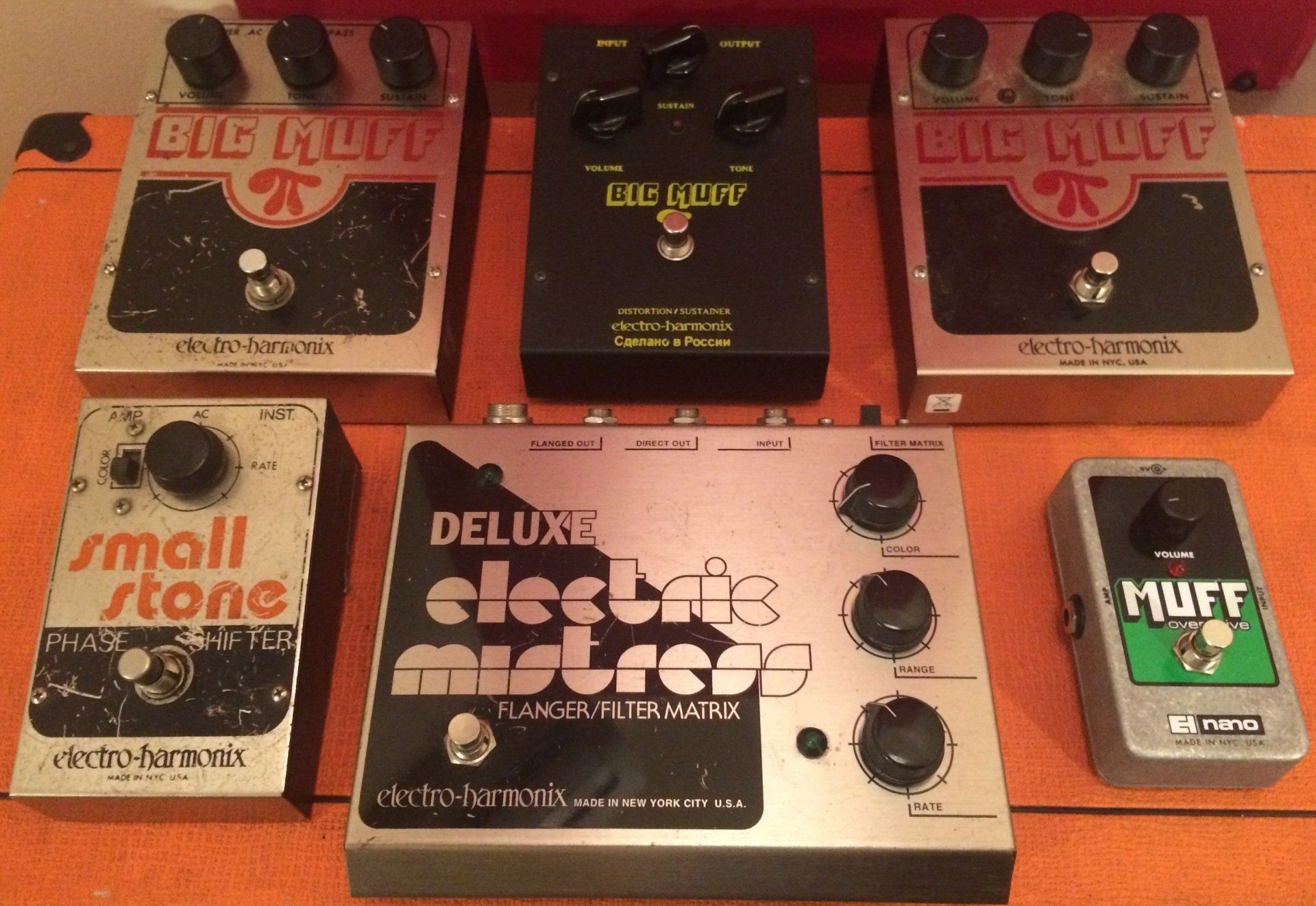
Our extensive collection of effects pedals at New Cut Studios is lacking a Whammy but we have several Muffs, both old and new — and as luck would have it, we seem to have the main models of Muff employed by Jack during his time as a White Stripe. The top row in the above image of the New Cut Electro-Harmonix arsenal goes like this: Big Muff
π Red & Black version 6, 2nd edition from 1981; Black Russian Sovtek, version 8, circa 1999; and standard Red & Black NYC re-issue version 9, c.2000 with no Tone Bypass switch. The 1981 v.6 top left is easy to distinguish from the 2000 v.9 opposite as it has no LED between Volume & Tone pots and it has no battery hatch underneath. But it’s a lot harder to distinguish from an old version 3 without looking inside at the transistors (I checked, they’re 2n5088 NPN on the standard EH3034 PCB). Incidentally the Electric Mistress in the picture is a rare version (despite only being a 1999 version 4 reissue) as it is missing the dot on the second
i of the screen print. The extra LED is a mod for rate indication. Our v.9 NYC Muff is definitely in the same family as it’s v.6 sire but it doesn’t quite cut the way the older pedal does. In fact, in comparison it’s a little wooly (though not in a Zvex way). It’s almost like it was being tailored towards the grunge market. Surely not.
Touring musicians often own a lot more gear than most people who like to speculate on forums (though there are some serious amateur collectors out there). Maybe you only want one Big Muff — your idol probably has 10 *******. So which one did they use to record your favourite song? Maybe there was an even older, much-more-major-mojo, Muff found in the pedal cupboard at the studio that sounded better than the three they brought with them. Just another reason why pointing to photos snapped over the top of a muso’s wedges might not evidence an informed opinion on their recording practice. Now here’s another roadie observation for you, where possible we like to have a touring rig that never get’s messed with. Backline techs hate it when musicians go into the lock-up. They always make a mess and they often break things; it’s like letting your kids play with the train set unsupervised. And no, they will not put it away tidily afterwards. It’s often the case that musicians will have a bomb proof, road-worthy pedal board built for them that never goes anywhere near a recording studio. I’ve made a few myself over the years, including the boards themselves (I stuck an image at the end of this episode showing a pedal board I knocked up, because I noticed I used a Muff and a Whammy when laying it out). And if the band are top headliners there will be a back-up pedalboard, and probably also a B-Rig board for festival leap-frogging. So wherever possible (especially as these days management don’t want to pay for crew to be around much during rehearsals, let alone during the recording process), we will try to keep touring equipment away from unsupervised usage. Because we are the ones who get shouted at when the gear doesn’t work even though we are not the ones who kick the shit out of it whilst full of adrenalin and god knows what else.
“I got a job for Salvation Army…”
I think I only spent time around The White Stripes once, and it just happened to be right at the very start of their
Elephant expedition. I was working for stage manager & pirate captain Clive Taylor on a Channel 4 TV show called
The Cut ********. It was shot at the Ocean, a venue that used to be on the other side of Mare Street from the Hackney Empire and it was presented by Jo Whiley. Looking it up I find that it was November 12th 2001, just 5 months before they went to record
Elephant at Toe Rag — which was just a 20 minute walk from the Ocean. And of course that November was when they first went to try out Liam Watson’s studio, to record ‘Well It’s True That We Love One Another’. Maybe they recorded it that very day. They’d not long finished their first short UK tour of only about 10 dates that August (when they’d met Watson) and were just starting a proper European tour, still in support of
White Blood Cells. They had only recently broken onto the scene in the UK like some mad, Mid West crossbreed of The Carpenters and the MC5.
My over-riding impression of the TV show was how cramped it usually was to get rolling risers around the set with larger bands. The White Stripes were much more manageable. I wish I’d paid more attention to the equipment (especially the amps) and taken some photos. I’m pretty sure that the Whammy was still the XP-100 (I'm sure I remember one of their crew pointing out that it was a Whammy-Wah when I remarked on it) and that the Jetson still had both pups. I vividly remember Meg’s ice cream swirl resonant head when we were setting up and her style of playing during the camera passes. Trouble is my memory of everything I was working on around that time is a bit sketchy: my first child Eloise was due 10 days after this shoot and she was born within the month, so I think I can be excused for my level of distraction. Here’s a clip from that TV gig which showcases the K6533 and the NYC Muff admirably.
Liam Watson’s approach to recording The White Stripes made a huge contribution to their career. The choices he made were fruitful decisions in every way. Vintage mics, into a small analogue desk and out to a quality analogue tape machine. That’s how we prefer to do things at New Cut Studios as well. And if you like vintage amps and want to go through more than one, well, we’ve got plenty to choose from — as well as a large collection of effects pedals. Check out our Equipment list from the menu in the header. Want to double track your vocals with a U87 but also send it down an SM7B through a Selmer Little Giant and out into an AKG D58E/200 maybe? Sick of staring at dozens of tracks of vocal takes and a blizzard of guitars? Don’t know where the plug-ins end and the music begins? Come and make a recording at New Cut Studios.
I am hugely indebted to Kit Rae’s exhaustive History Of All Versions Big Muff webpages as the only resource worth consulting on the subject; especially his in-depth discussion of the varieties used by Jack White; I wish I’d found that particular page earlier. His website is fascinating and informative and will give you a much better understanding of the Big Muff and it’s place in Rock n’ Roll history.
* They had already taped one of the album’s songs, ‘Well It's True That We Love One Another’, at Toe Rag the previous November and would add another recorded at BBC Maida Vale for a Radio 1 Evening Session: the excellent cover of ‘I Just Don't Know What to Do With Myself’. It’s perhaps not quite as great a Bacharach & David cover as The Stranglers version of ‘Walk On By’ — but it’s pretty damn good. Someone even managed to persuade Sofia Coppola to film Kate Moss pole dancing to it for a promo. Not my cup of tea, but it’s alright if you like watching skinny girls who can’t really dance.
** Even Studer’s legendary J37 4-track didn’t arrive until 1964. The Swiss company were so careful in perfecting the best tape recorders conceivable, that they didn’t release the A80 until 1970.
*** I have a particular fondness for ‘Seven Nation Army’. In September 2013, in the interactive museum/gallery which at the time was called @Bristol (now re-named with the even sillier monicker We The Curious) I was playing with magnets, making bridges of iron filings with my eight-year-old twins. I heard the menacing rhythm of that E minor riff played perfectly in hauntingly hollow tones. Looking around I saw my eldest daughter Eloise, not quite 12 years old, sat at a kind of xylophone made from the long yellow polypropylene plastic pipes used for gas mains. There she was, playing ‘Seven Nation Army’ with beaters like foam rubber ping-pong bats. I was very proud. Incidentally I first saw an instrument just like that in Blue Man Group’s show
Tubes at the Astor Place in December 1991. Back then it was the hottest ticket off-Broadway and I still don’t know how my then girlfriend got hold of them, but I think her public schoolboy brother had a connection.
**** As I was writing this I got distracted by plastic guitars and ended up writing far too much to include here about the history of Res-O-Glas Airlines: in large part because I also had a modern Eastwood repro version of the Jetson/Hutto model in my hands at the time. The synchronicity of this guitar being in for repair at exactly the same time meant I tried to work it into this article but I ended up with an entirely separate
Jetson blog.
***** Later the same evening (April 8th 2022) Jack White proposed to his girlfriend onstage at The Masonic in Detroit, and then promptly married her for an encore. In November 2014 I was there with Chrissy Hynde when we played the building’s Jack White Theatre. Formerly the old Cathedral Theatre, it was christened for White after he donated money to save the building’s venues and keep them open. We also got given a private tour of the complex, which was extremely creepy and seriously weird. It is the largest Masonic Temple in the world and from the outside it looks like a cross between the Nazi Flakturm IV G-Tower bunker in Hamburg and a high-rise cathedral. From the inside it seems even bigger and contains a whole series of venues and theatres, chapels & sanctums. It is an extremely atmospheric place.
****** I used to wonder if the SV suffix was an abbreviation for the ‘silver’ face plate and knobs, which are really brushed aluminium in a totally ’70s HiFi separates stylee. Selmer Production Manager John Weir who helped develop the range claims the initials stood for Selmer Valve — the SV was to distinguish them from the host of cheap SS (solid state) amps that were increasingly prevalent at the time. Most of the changes Selmer made to it’s amplifier lines over the years were cosmetic, the basic circuits didn’t change very much, particularly the popular Treble N’ Bass and Zodiac amps. The Tn’B started out as the Bassmaster in 1962 and the Zodiac was a more marketable 2 x12 version of the Selector-Tone Automatic 1x15 from 1961. The original Selmer Bassmaster was basically a British beat era copy of the 6G6 Brownface Bassman, Selmer even copied the Fender piggyback slide brackets exactly. The 30w Bassmaster then grew into the 50w EL34 Treble N’ Bass — a solution that Marshall later adopted for their marvellously well marketed Plexi. I wrote a little more about those amps in my
Traynor Bassmaster article.
******* J Mascis has an entire museum collection of about forty different Muffs and just last week Electro-Harmonix released a signature pedal based on his famous purple Rams Head model. If you want a really close copy of that sound however you need to get hold of the Fuzz Munchkin from Tym's Guitars in Brisbane — who reverse engineered his circuit directly from J's touring pedal when it was in for repair. I called in to the shop a few years ago to buy one but Tym told me he'd sold out.
******** Clive was Stage Manager for TV and former Kentish Town Forum SM Brian Concannon ran the venue side of the gig. Clive took care of the live music side of many TV shows and I worked with him on a lot of TV stuff for different channels in different venues and studios around London.
I'll have to have a think about which stories I can tell from those years.
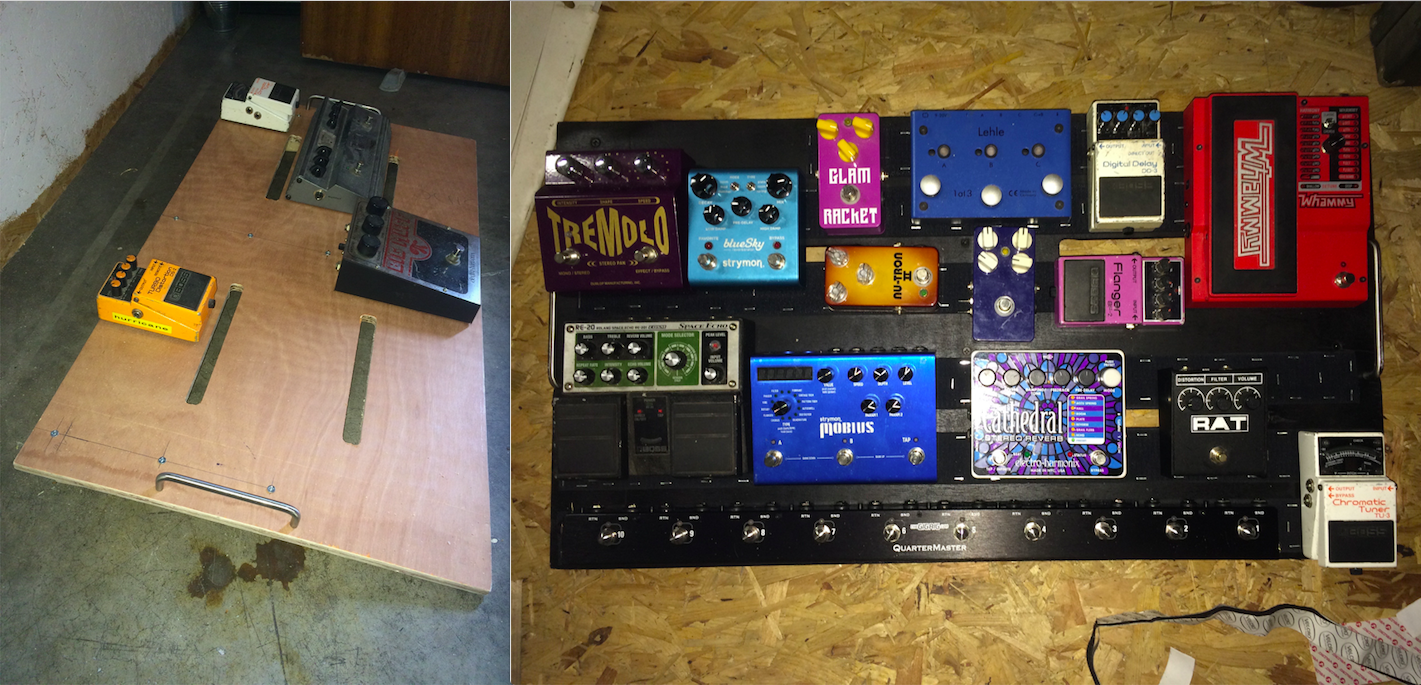
©️ Mark Vickers July 2022

